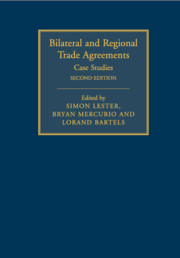Book contents
- Frontmatter
- Contents
- Contributors
- Table of cases
- Table of treaties and international agreements
- List of abbreviations
- 1 The United States–Korea Free Trade Agreement
- 2 EU–Korea Free Trade Agreement
- 3 United States–Colombia Trade Promotion Agreement
- 4 China–New Zealand Free Trade Agreement
- 5 China–Taiwan Free Trade Agreement
- 6 The ASEAN–Australia–New Zealand FTA (AANZFTA)
- 7 The CARIFORUM–EU Economic Partnership Agreement
- Index
4 - China–New Zealand Free Trade Agreement
Published online by Cambridge University Press: 05 December 2015
- Frontmatter
- Contents
- Contributors
- Table of cases
- Table of treaties and international agreements
- List of abbreviations
- 1 The United States–Korea Free Trade Agreement
- 2 EU–Korea Free Trade Agreement
- 3 United States–Colombia Trade Promotion Agreement
- 4 China–New Zealand Free Trade Agreement
- 5 China–Taiwan Free Trade Agreement
- 6 The ASEAN–Australia–New Zealand FTA (AANZFTA)
- 7 The CARIFORUM–EU Economic Partnership Agreement
- Index
Summary
Introduction
Even though China and New Zealand are far apart, bilateral trade between the two countries has been growing fast. For example, while bilateral trade was only US$1.8 billion in 2003, it has more than doubled to US$3.7 billion in just four years. Of the total trade, exports from China contributed 60%, or US$2.16 billion, of total trade volume with more than half coming from two sectors: machineries and textiles. Of the US$1.54 billion worth of New Zealand exports to China, the majority consisted of dairy products, wood and pulp, and wool.
As China exports more to New Zealand than the other way around, one might assume that China was the one pushing for the free trade agreement (FTA). However, for the following reasons, it seems the reverse is more likely to be true. First, the sizes of the two economies are different. While Chinese exports are bigger in absolute terms than New Zealand exports, they constitute a much smaller share of China's total global exports due to China's much larger size and the corresponding small size of New Zealand. In 2008, for example, 5.9% of New Zealand's total exports were to China, making China the fourth largest export partner of New Zealand. In contrast, exports to New Zealand made up only 0.2% of China's total exports, placing New Zealand 59th among China's exporting partners. In other words, China is a much more important export destination for New Zealand than New Zealand is for China. Therefore, from New Zealand's perspective, signing an FTA is a good way to lock in the Chinese export market. Second, the initial levels of protection were different. Prior to the conclusion of the FTA in 2008, only 8.3% of China's tariff lines were set at zero, while 57.6% of New Zealand's tariff lines were already duty-free. Thus, further liberalization under the FTA would bring more commercial benefits to New Zealand as the barriers were higher on the Chinese side before the FTA. In particular, China had high tariff rates for several main export items of New Zealand. For example, before its WTO accession, China's tariff rates on dairy products were as high as 50%. While they have been greatly reduced after its accession, the final MFN rates in 2005 were still between 10–20%. At the same time, China's dairy market has huge growth potential.
- Type
- Chapter
- Information
- Bilateral and Regional Trade AgreementsCase Studies, pp. 77 - 96Publisher: Cambridge University PressPrint publication year: 2016
- 2
- Cited by



